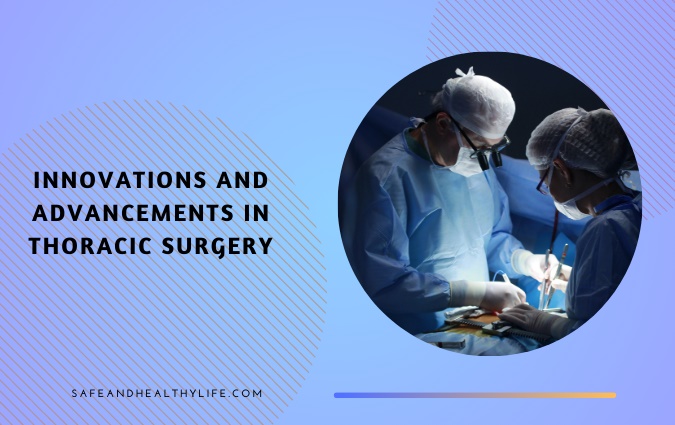
Thoracic surgeons have long been pioneers in transplantation, delivering the first successful lung, heart-lung, and triple organ transplants at Brigham and Women’s Hospital.
They have also led the way in minimally invasive lung surgery.
Uniportal Robotic Thoracic Surgery
Robotic surgery is a minimally invasive procedure that can remove lung cancer or other abnormalities.
During the process, your doctor will make small incisions (cuts) in your chest and insert a camera to see the inside of your body. A robotic tool is inserted through the other incisions and controlled by your surgeon at a nearby console.
A thoracic surgeon like Armen Parajian may benefit greatly from several breakthroughs, and these developments have the potential to change the field of thoracic surgery completely.
This technology is very effective in lung cancer surgery, anterior mediastinal tumors, thymectomy, diaphragm surgery, and esophageal hernia repair.
It is also able to address conditions that are not suitable for open surgery, such as pulmonary anatomic resections. A uni portal surgical approach has emerged as a possible improvement on the multiport video-assisted thoracoscopic surgery (RATS) technique to enhance patient outcomes further.
This is an attempt to minimize the number of incisions, improve oncological outcomes and allow for increased surgeon comfort.
Remote Wireless Steerable Endoscope
Several telerobotic systems for minimally invasive surgical procedures were developed for the throat and upper airways. These teleoperated endoscopic robots enable the surgeon to perform various therapeutic interventions without incisions, such as tracheal stenting or swallowed seed injections.
The master-slave robotic system for MIS consists of a control console that translates the surgeon’s hand movements using a nonwearable wrist and elbow position sensor, cable-actuated position sensors, and optical rotary encoders on the slave device. It also provides 3D stereo images and haptic feedback of the tool’s position.
Wireless capsule endoscopy (WCE) is a disruptive technology in gastrointestinal (GI) screening, diagnosis, and intervention due to its ability to overcome the discomfort associated with conventional endoscopy, thus encouraging patients to undergo GI tract examinations and allowing mass GI screening programs.
However, its reliability, diagnostic accuracy, and therapeutic functionality remain limited by the operator’s skills and the complexity of the procedure. The emergence of microsystem technologies and the integration of telerobotics is expected to improve the performance of WCE.
Minimally Invasive Thoracic Surgery
Lung surgery traditionally required a major open procedure involving making large incisions and spreading the ribs apart with retractors.
However, new surgical techniques allow surgeons to access the lungs through less invasive methods. This is a significant advance, and many experts consider it the most important innovation in thoracic surgery.
During minimally invasive thoracic surgery, a tube with a camera (called a thoracoscope) is inserted through a small incision in the chest wall. The camera sends images to a video monitor, allowing the surgeon to operate through this tube and avoid making larger incisions.
The surgeon must be skilled at using these instruments, but the resulting operation can be much quicker and more comfortable for patients than an open procedure. The procedure can also help patients recover faster and stay out of the hospital longer.
Robotic Stapling
Robotic stapling is an innovation that may revolutionize surgical outcomes for thoracic procedures. It allows surgeons to create a staple line in tissue with high accuracy. It minimizes leakage, all while ensuring that adequate blood flow is maintained.
Despite the relatively recent (2014) introduction of the EWSS, more comparative perioperative data is available regarding stapling-related complications. In addition, the FDA MAUDE database contains only limited information regarding device malfunction and stapling-related complications.
The EWSS, like all da Vinci robotic systems, operates under surgeon supervision. Consequently, the system does not qualify as true level 1 automation (or pure robot control) because it requires surgeon input at every procedure step.
This allows the lead surgeon to stay at the patient’s bedside rather than being positioned at a console, reducing communication barriers between the healthcare team.
Using wristed instruments also enables the surgeon to manipulate tissue with greater flexibility than standard VATS tools and perform tasks with minimal disruption of the chest wall.
About The Author:
Steve Barker is an independent blogger and content writer. He is a pharmacist and nutritionist by profession. He has vast knowledge in the healthcare field. He loves to share his thoughts with his informative pieces and connect with the audience.

![[Infographic] Technological Advancements that Benefited Legal Practitioners Infographic](https://www.safeandhealthylife.com/wp-content/uploads/2017/03/Infographic.png)


